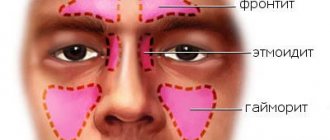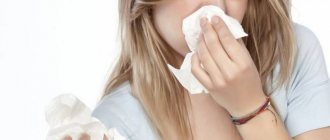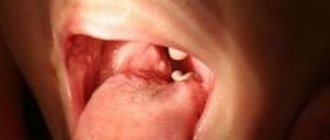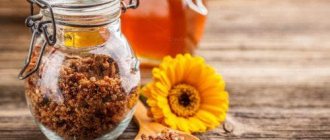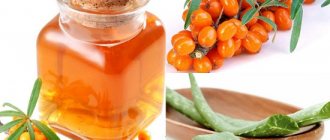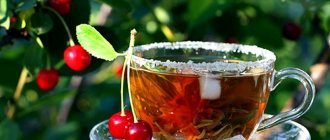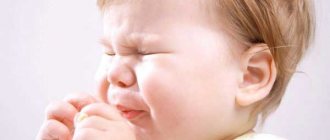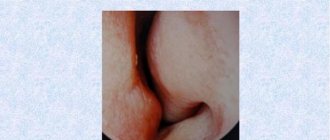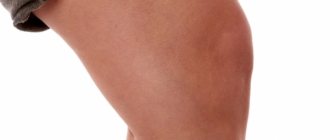Sinusitis is an inflammatory lesion of the mucous membrane of the paranasal sinuses. The most commonly diagnosed inflammation of the maxillary sinus is sinusitis, the second most common is ethmoiditis - damage to the ethmoidal labyrinth, then frontal sinusitis and sphenoiditis - the process occurs in the frontal and sphenoid sinuses, respectively.
Sinusitis is a common ENT disease that requires complex treatment.
Acute and chronic sinusitis occupy a leading position among infectious and inflammatory diseases of the ENT organs and account for up to 60% in the structure of otorhinolaryngological morbidity.
Objectives of sinusitis therapy
An integrated approach is important in the treatment of sinusitis. It is impossible to cure a disease by taking one remedy alone. Therefore, otolaryngologists develop individual treatment regimens using different drugs to achieve the main goals of disease therapy. These include:
- elimination of swelling and inflammation of the nasal mucosa;
- ensuring the outflow of mucopurulent secretions accumulated in the nasal sinuses;
- elimination of pathogens of the inflammatory process;
- elimination of unpleasant symptoms and pain;
- preventing the development of complications and further spread of the inflammatory process;
- activation of the body's protective properties to fight the disease.
Causes and features of the development of sinusitis
The appearance of inflammation in the sinus is influenced by:
- anatomical features (ridges, spines or deformations of the nasal septum);
- decrease in the protective mechanisms of the mucociliary system of the nasal cavity and paranasal sinuses as a result of too frequent use of nasal drops;
- prevalence of viruses, pathogenic microbial flora, protozoa in the environment;
- unfavorable environmental and social factors;
- the presence of chronic foci of infection;
- concomitant chronic diseases;
- insufficiency of vitamins and microelements in the diet;
- frequent psycho-emotional stress;
- general decrease in immunity.
One of the risk factors for developing sinusitis is a deviated nasal septum.
The etiological factors for the development of sinusitis are viruses or a mixed viral-bacterial infection. The most common include influenza viruses, parainfluenza, entero- and adenoviruses. Among the bacterial pathogens identified are streptococci, staphylococci, and hemophilus influenzae. There is an increasing role of gram-negative bacteria, as well as protozoa: mycoplasma, ureaplasma, chlamydia, etc.
The main cause of sinusitis is viruses or a mixed viral-bacterial infection.
As a result of primary damage by the viral agent, the mucous membrane of the nose and sinuses swells and begins to actively produce large amounts of secretion. Further, due to a decrease in the diameter of the outlet, mucus stagnates in the sinus cavity. The exudate irritates the surrounding tissues and leads to an even greater increase in edema. The pressure in the sinus cavity increases. Bacterial flora joins in, aggravating congestion and swelling.
The process of remodeling or changing the sinus mucosa during chronic sinusitis creates conditions for the weakening of protective mechanisms and leads to even greater susceptibility to the effects of various types of microorganisms.
Vasoconstrictors
Often, treatment of any sinusitis begins with the use of vasoconstrictor drops and sprays. After all, it is these drugs that quickly eliminate nasal congestion, restore the patency of the nasal passages, which in turn normalizes breathing and allows for the free outflow of secretions from the sinuses. The use of vasoconstrictors brings noticeable relief to the patient. After all, eliminating the main symptoms of the disease helps relieve headaches and improve general condition.
Today on the pharmaceutical market there are many names of drugs from this group. There are practically no fundamental differences in their effects on the body. The only difference that matters is the duration of the therapeutic effect. There are short-, medium- and long-acting vasoconstrictors. Preference should be given to drugs with long-term effects. These include all products with oxymetazoline as an active ingredient.
Group representatives:
- Nazivin;
- Nazol;
- Knoxprey;
- For nose;
- Tizin;
- Rinazoline;
- Vibrocil;
- Galazolin et al.
Nasal rinsing medications for children and adults
The procedure of rinsing the nose is a mandatory component of treatment for rhinitis and sinusitis. Drugs used for this purpose help relieve irritation, moisturize the mucous membrane and increase its resistance to new infections and viruses. Unlike homemade saline solution, ready-made products contain sterile sea water with beneficial microelements preserved in it.
There are a huge number of drugs on the pharmacological market. The most popular of them:
- Humer. The line of products includes drugs for adults and children aged 1 month and older.
- Aqualor. Aerosols and sprays in various forms and dosages allow you to choose products for both adults and newborns. There is a separate line with aloe and chamomile extract.
- Aqua Maris. The classic solution in the form of drops is suitable for children up to one year old. From one year onwards, use in the form of a spray is indicated. The line also contains products with a hyperconcentrated solution of sea salt or additional active ingredients - dexpanthenol or ectoine. In the treatment of sinusitis, these categories of products, produced under the names Aqua Maris Strong and Aqua Maris Plus, are most often used .
That, in fact, is all you need to know about the drugs used in the treatment of sinusitis. But do not forget that your knowledge alone is not enough to make a diagnosis and draw up a treatment plan. So awareness of the intricacies of pharmacology does not replace consultation with a specialist.
Antibiotics
Antibiotics for sinusitis are not always needed. They are necessary only if the nature of the disease is confirmed to be bacterial. Most often, the choice of a suitable drug is carried out empirically, since there is no time to wait for the results of bacterial culture. In this case, preference is given to an antibiotic that is active against the main pathogens of sinusitis in the region.
For mild cases of the disease, it is recommended to treat with local antibiotics. The most famous drugs: Isofra and Polydexa. Isofra contains only an aminoglycoside antibiotic and auxiliary components. Polydexa is a combination drug. It contains 2 antibiotics, a vasoconstrictor and a hormonal substance. This significantly expands the capabilities of the drug, but causes a considerable list of contraindications and side effects.
Antibiotics for systemic use for moderate severity of the disease are used in the form of tablets, capsules and suspensions. Severe forms of sinusitis may require injections of medications.
First-line drugs for sinusitis are penicillins, among which amoxicillin and its combination with clavulanic acid are preferred.
If penicillins are insufficiently effective against pathogens, then a representative of cephalosporins is prescribed. The use of these drugs is impossible if there is intolerance to penicillins due to the similarity in structure and the same reaction of the body to their use. In such cases, a suitable macrolide drug is selected.
Typically, antibiotics from these 3 groups are sufficient to eliminate pathogens. But if pathological microbes are highly resistant and cannot be affected by them, then fluoroquinolones, some tetracyclines, carbapenems and aminoglycosides can be included in the treatment regimen.
List of main antibiotics used for sinusitis:
- Amoxicillin;
- Amoxiclav;
- Augmentin;
- Flemoxin Solutab;
- Cefuroxime;
- Cefix;
- Cefotaxime;
- Ceftriaxone;
- Fromilid;
- Azithromycin;
- Clarithromycin;
- Sumamed;
- Lomefloxacin.
Healing drops
Drops are a traditional remedy that is part of a complex of rehabilitation therapy for inflammation of the nasal cavity. Pharmaceutical drugs, as a rule, have a vasoconstrictor effect. But medicines prepared independently often have medicinal properties. And you shouldn’t be surprised if the ENT specialist indicates the composition of such drops on the prescription.
Treatment of sinusitis at home is more effective when using drops from a mummy solution. Known back in Tibetan medicine, it has a positive effect on a variety of body systems. This useful product can be purchased at the pharmacy chain. For use, a two percent solution is suitable, which is instilled in 3-4 drops three times a day. Parallel intake of mumiyo orally will enhance the therapeutic effect.
The juice of beets, carrots, onions, garlic, Kalanchoe and aloe has a bactericidal effect. Drops from these plants also help relieve congestion. But when using them, you must be careful not to “burn” the mucous membrane. The dangerous properties of the drops will be mitigated by sunflower, olive oil or sea buckthorn oil. The latter can even be used as an independent medicine.
Sulfonamides
Representatives of the sulfonamide group today are quite rarely prescribed for sinusitis, which is explained by the availability of more effective drugs. Drugs in this group exhibit an antibacterial effect against many pathogens of sinusitis.
Sulfonamides are prescribed only if the sensitivity of the pathological microflora to their action is confirmed in case of intolerance to antibiotics, or to enhance their effect in very severe cases of the disease.
The most famous representative of sulfonamides is Biseptol.
Traditional methods of treating sinusitis
If you treat sinusitis at home, then treatment with folk remedies will be the most acceptable and effective. A combination of drug treatment with traditional methods also gives a good result.
Here are some of them.
Ointments
- Buy Vishnevsky ointment at the pharmacy, squeeze a small part from the tube into a teaspoon (without a slide), add 1-2 drops of aloe juice, onion, propolis and honey. Mix everything and put it in your nose overnight.
- To 1 tsp. baby cream you need to add 2 drops of camphor and menthol oil.
Drops
- Instill mummy solution (2%) up to 3 times a day.
- Freshly squeezed Kalanchoe juice, you need to drip it up to 3 times a day.
- Boil 50 g of sunflower oil and then cool, add the juice of ½ small onion (grate the onion and strain off the juice). After instillation, do not blow your nose for 5 minutes. Drip 4-5 drops.
- Radish juice. The radish is grated and the juice is strained. Apply 2 drops 3 times a day.
Nasal rinse solution
Using solutions to treat sinusitis with folk remedies, carry out the rinsing yourself according to the scheme described above. Nasal rinsing is considered the most effective method of treatment.
- 3 drops of iodine and 3 drops of potassium permanganate should be mixed with a glass of warm water. Rinse your nose with a well-mixed solution.
- Add 5 drops of iodine and a teaspoon of sea salt to a glass of warm water. Stir until the salt is completely dissolved. Use for rinsing.
- Peel a medium-sized onion and chop very finely. Then pour boiling water and let stand. When cool, strain and add a tablespoon of honey.
- A decoction of St. John's wort, chamomile and calendula. Mix in equal quantities. Brew 1 tablespoon per glass of water. Pour boiling water, leave until cool, strain.
Inhalations
We have already described the inhalation technique in the “Treatment at home” section; here we provide compositions for inhalation.
- Boil the potatoes without peeling them (with their skins on). Drain the water and return to low heat until the remaining water evaporates. Then mash the potatoes a little and breathe over it.
- Sprinkle boiled and slightly mashed potatoes with baking soda (like salt). Breathe over it for 10-15 minutes.
- Fir oil (5-6 drops) is dissolved in a glass of very hot water. Breathe until you can no longer smell the pine needles.
- Dry menthol is added to very hot water. Breathe for no more than 10 minutes.
- Add 1 tsp to 0.5 liters of boiling water. propolis in alcohol.
If you breathe over boiling water, use special nozzles on a kettle or nebulizer. If you don’t have a nebulizer, breathe over very hot water in a bowl on the table. Do this carefully.
Warming the nose for sinusitis
You cannot talk about how to treat sinusitis with folk remedies, without warming up recipes. Doctors have ambivalent attitudes towards it, but traditional healers consider warming to be effective and useful.
- Boil an egg hard, peel and apply one at a time to the outer side of the nose. Hot eggs should be wrapped in a dry cloth to avoid getting burned.
- Pour dry warm sea salt and river sand 1:1 into a bag (you can take a baby sock). Keep until the mixture cools down.
- Rye flour and fresh honey are mixed and two flat cakes are made. They are heated in a steam bath and applied warm to the nose. Cover the top with polyethylene.
Why is prevention important?
Scientists believe that one of the main causes of sinusitis is decreased immunity. Therefore, hardening, a healthy lifestyle, and proper nutrition are very important for the prevention of this disease.
Mucolytics
It would seem that mucolytics are necessary only for coughs. But it is not so. After all, a lot of viscous secretions also form in the sinuses during sinusitis. To get rid of the disease, it is necessary to restore the sterility of the sinuses, and for this the mucopurulent secretion must be evacuated from there. It is with the aim of reducing the viscosity of secretions and stimulating their outflow to the outside that mucolytic drugs are used for sinusitis. Most often prescribed for oral administration:
- ACC,
- Fluditek,
- Acetylcysteine,
- Mukodin.
You can’t ignore the nasal spray Rinofluimucil, which has a mucolytic effect. It contains acetylcysteine, which, when it enters the sinuses, quite quickly breaks the disulfide bonds of the thick secretion. The drug also contains a vasoconstrictor substance, which ensures the elimination of swelling of the mucous membrane and the free flow of the liquefied contents of the sinuses.
The best antibiotics for sinusitis - list
All antibiotics used for sinusitis in adults can be divided into two main groups: local and systemic. And before moving on to the trade names of the most effective of them, we should take a closer look at each group.
It is advisable to use local antimicrobial agents only at the initial stage of development of the inflammatory process.
- The big advantage of their use is that they act only at the site of use; they are not absorbed into the blood, and therefore do not cause systemic side effects.
- Therapy generally lasts from five to seven days, usually this is enough to relieve all negative symptoms.
- With this type of treatment, antibiotics are injected directly into the nose and act only in the paranasal sinuses.
Systemic antibiotics affect the body as a whole . Most often they come in the form of tablets for oral administration. They are used when application for three days does not provide relief from local remedies. Depending on the severity of the pathology and the sensitivity of the microflora to a particular type of drug, appropriate therapy is prescribed.
Isofra
An antimicrobial agent for topical use, available in the form of a nasal spray.
The main active agent is framycetin (from the group of aminoglycosides). Its main advantage is the safety of use in adults and children, starting from infancy. Directions for use in adult patients: spray the product five to seven times a day into each nasal passage. As for children, the dosage is discussed with the doctor purely individually.
An article on the topic - which is better: isofra or polydex.
Polydexa
A drug with a combined effect.
It contains three types of active ingredients: antimicrobial (neomycin and polymyxin), steroidal anti-inflammatory (dexamethasone) and vasoconstrictor (phenylephrine). It is the rich set of components that allows us to approach the problem in a comprehensive manner. The product fights the very cause of the disease, removes the inflammatory process, and also eliminates nasal congestion. Directions for use in adults: inject the drug three to five times a day into each nasal passage. Children from thirty months - the number of uses should be reduced to three times a day.
Article on the topic - cheap analogues of Polydexa.
Bioparox
An antimicrobial agent used to treat diseases of the nose and throat. The main component is fusafungin, which in addition to its antibacterial effect has an anti-inflammatory effect. The drug is used in the treatment of sinusitis, pharyngitis and laryngitis in patients over 36 months of age. Sinusitis can be treated with Bioparox only in the initial stage.
Directions for use in adult patients: inject the solution four times a day into each nasal passage (two injections). Children only need to use the bottom squirt three to four times a day.
This drug is currently prohibited in Russia, but you can choose one of its analogues.
Azithromycin
A systemic drug effective against most bacteria known to modern medicine. A characteristic feature is the high rate of absorption and entry into the bloodstream.
After administration, dizziness, headache, increased agitation or fatigue, tachycardia, dyspepsia and other manifestations may occur. The product is prohibited for use in case of liver dysfunction, during pregnancy and lactation, as well as hypersensitivity to the components.
Directions for use in adult patients: once a day, one capsule for three to five days.
Herbal remedies
Herbal remedies include the most famous medicine for sinusitis - Sinupret. This product contains extracts of 5 medicinal herbs, which provide anti-inflammatory, secretolytic, secretomotor, decongestant, immunostimulating, antiviral and some analgesic properties.
Another herbal remedy for sinusitis is Sinuforte. This drug is available in the form of a spray and helps to naturally cleanse the nasal passages and sinuses of the accumulation of mucus and pus.
Quite often, these 2 drugs are classified as mucolytics because of their properties to thin out secretions and facilitate their removal.
Local vasoconstrictor drugs
When treating adult patients, vasoconstrictor medications are used for sinusitis to reduce the amount of mucus discharge, improve breathing through the nose, and relieve swelling from the mucous membranes.
These sinusitis remedies are available in the form of sprays and nasal drops. There is also a tablet form of the drug, however, its use is inappropriate.
When using decongestant medications, you need to remember that they dry out the mucous membranes over time and can also be addictive. In this regard, within a few days after starting to take such medications, it is advisable to switch to a more gentle drug.
The most common drugs from this series include the following drugs:
- otrivin;
- sanorin;
- vibrocil;
- tizin;
- nazol.
We should not forget about the adverse reactions that may occur when using vasoconstrictors. Let's consider the main ones:
- Slight tachycardia (fast heartbeat);
- Inability to completely clear the nose of mucus;
- Runny nose caused by the components of the drug.
Taking vasoconstrictor and decongestant drugs should be started only after consultation with your doctor and subject to the optimal dosage.
Glucocorticosteroids
The use of glucocorticosteroid drugs is indicated for severe forms of sinusitis, accompanied by severe inflammatory processes. They quickly eliminate swelling and inflammation of the mucous membrane, normalize nasal breathing, and eliminate signs of allergies. However, the use of hormonal drugs, even topically, is quite strictly limited due to serious side effects and a large number of contraindications. Most often prescribed:
- Baconase,
- Flixonase,
- Nasonex,
- Avamis.
Possible complications
A predisposing factor in the development of purulent-septic and intracranial complications is the high resistance of microorganisms to the most commonly used antibacterial drugs in medical practice. To prevent an unfavorable outcome, it is necessary to strictly follow the doctor’s recommendations and adhere to the prescribed antibiotic regimen.
The starting regimen of antibacterial therapy for sinusitis in adults includes broad-spectrum antibiotics: Amoxicillin, Flemoxin Solutab, Cefuroxime, Azithromycin.
Complications involving the knee joint and bacterial damage to internal organs (heart, kidneys) are also possible.
Antiseptics
Antiseptic solutions are prescribed for bacterial sinusitis to enhance the effects of antibiotic therapy, manifesting their effect directly at the site of the inflammatory process. They can be used in the form of drops, inhalations and for rinsing the nasal cavities. Antiseptics include:
- Miramistin,
- Rotokan,
- Protargol,
- Dioxidin,
- Malavit et al.
Drops for sinusitis and sinusitis
For sinusitis and sinusitis, nasal drops are often used, as they act quickly and relief occurs almost immediately. In addition, drops have many more advantages compared to the tablet form of the drug, since only a small part of the active substance enters the systemic bloodstream, which means that side effects occur much less frequently.
However, it is worth remembering that literally after 3-5 days the body becomes accustomed to the drops. Therefore, they are often supplemented with drugs of another form of longer action.
Most often, drops such as Naphthyzin, Nazivin, Galazolin, Sanorin are used for therapy.
Homeopathic medicines
You cannot ignore homeopathic medicines for the treatment of sinusitis. Among them, Cinnabsin tablets are the most popular among ENT doctors and patients. This drug eliminates swelling of the mucous membrane, normalizes nasal breathing, relieves headaches and a feeling of pressure in the area of the inflamed sinuses. Cinnabsin also increases the body's protective properties and prevents relapses of the disease.
In addition to it, the following have noticeable effectiveness:
- Engystol,
- Euphorbium Compositum,
- Echinacea Compositum,
- Lymphomyazot.
How to treat sinusitis in adults?
The starting regimen of antibacterial therapy for sinusitis in adults includes broad-spectrum antibiotics: Amoxicillin, Flemoxin Solutab, Cefuroxime, Azithromycin.
Depending on the data obtained from the cultural research method, the ENT specialist may leave or replace the drug with another antibiotic that has more pronounced activity against the detected flora. Thus, when enterobacteria are detected, the prescription of IV generation cephalosporins (Cefepime) or respiratory fluoroquinolones (Levofloxacin) is indicated.
The treatment regimen for sinusitis also includes decongestants. What it is? Decongestants are vasoconstrictors for intranasal use that reduce swelling of the mucous membranes, improve nasal breathing and reduce the risk of complications. Among vasoconstrictor nasal drops in adults for sinusitis and sinusitis, Nafazolin, Sanorin, Galazolin, Vibrocil are often used.
An important role in the treatment of sinusitis in adults is played by local therapy through inhalation or rinsing with antiseptic solutions that have antimicrobial and antiviral effects.
Rinsing the nose with antiseptic solutions is an important component of complex therapy for sinusitis.
When using antiseptics during rinsing, the optimal dose of the active component is delivered directly to the mucous membrane and to the site of inflammation.
Washings are distinguished by the simplicity and accessibility of administration to the area of pathological changes. They can be carried out at home. Antiseptic drugs for the treatment of sinusitis in adults (Chlorhexidine, Miramistin) have the following properties:
- low toxicity;
- bactericidal effect with a strong antimicrobial and antiparasitic effect;
- high activity;
- absence of damaging effects on tissue and the regeneration process.
Particularly important is the fact that, despite the long period of use of antiseptic drugs, therapy does not lead to allergic reactions, and the most common infectious agents do not acquire resistance to these drugs.
Bacteriophages are highly effective immunobiological antimicrobial drugs used in the development of resistance of the infectious agent to antibiotics
In the event of the development of resistance of the infectious agent to antibiotics, bacteriophages are actively used - these are viruses that selectively infect bacteria. These are highly effective immunobiological preparations with antimicrobial action. Their antibacterial effect is based on the introduction of the phage genome into the bacterial cell, followed by its reproduction and destruction of the infected cell.
Phage therapy is especially effective in the treatment of chronic inflammatory conditions against the background of reduced immunity, since the use of bacteriophages stimulates the activation of specific and nonspecific immunity factors.
Surgery
In a hospital setting, treatment of sinusitis is actively practiced by puncture of the maxillary sinus. The procedure is recommended to be carried out daily. The average course of treatment is 3–4 punctures. During this procedure, antiseptic solutions are also used. At the same time, the drug Betadine affects bacterial and viral pathogenic microflora. The maxillary sinus is washed with a 0.01% solution of Betadine, then 10 ml of a 0.1% solution of the drug is injected into the cavity.
For the polypous form of chronic sinusitis, surgical treatment is indicated
In the treatment of chronic sinusitis, both conservative and invasive methods are used. Thus, in the treatment of the polypous form of chronic sinusitis, loop polypotomy or opening of the paranasal sinus with subsequent removal of polyps and evacuation of pathological contents remains relevant. An alternative modern solution is minimally invasive endoscopic surgery, which shortens rehabilitation time and reduces the likelihood of postoperative complications. Laser technologies are also used in the treatment of various forms of chronic sinusitis.
Laser technology can be used to treat sinusitis
The criteria for the effectiveness of treatment of sinusitis in adults are the following:
- significant reduction in clinical manifestations;
- improved nasal breathing;
- headache relief;
- normalization of body temperature;
- reduction of hyperemia and swelling of the nasal mucosa during anterior rhinoscopy;
- gradual replacement of purulent nasal discharge with mucous;
- reduction of inflammatory changes in the sinus according to x-ray examination of the paranasal sinuses.
